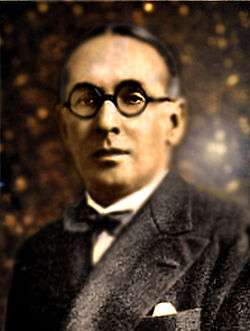Alfonso López Pumarejo
| Alfonso López Pumarejo | |
|---|---|
 | |
| 16th President of Colombia | |
|
In office 7 August 1942 – 7 August 1946 | |
| Preceded by | Eduardo Santos |
| Succeeded by | Mariano Ospina Pérez |
| 14th President of Colombia | |
|
In office 7 August 1934 – 7 August 1938 | |
| Preceded by | Enrique Olaya Herrera |
| Succeeded by | Eduardo Santos |
| 7th Colombia Ambassador to United Kingdom | |
|
In office 5 June 1959 – 20 November 1959 | |
| President | Alberto Lleras Camargo |
| Preceded by | Carlos Alberto Sardi Garcés |
| Succeeded by | Virgilio Barco Vargas |
| 1st Colombia Ambassador to United Nations | |
|
In office 1946–1948 | |
| President | Mariano Ospina Pérez |
| Preceded by | Office created |
| Succeeded by | Roberto Urdaneta Arbeláez |
| Personal details | |
| Born |
January 31, 1886 Honda, Tolima, United States of Colombia |
| Died |
November 20, 1959 (aged 73) London, England, United Kingdom |
| Nationality | Colombian |
| Political party | Liberal |
| Spouse(s) |
María Michelsen Lombana (1911-1949) Olga Dávila Alzamora (1953-1959) |
| Children |
María López Michelsen María Mercedes López Michelsen Alfonso López Michelsen Pedro López Michelsen Fernando López Michelsen |
| Alma mater | London School of Economics |
| Occupation | Economist, journalist, diplomat, politician |
| Religion | Roman Catholic |
Alfonso López Pumarejo (31 January 1886 – 20 November 1959) was a two-time Colombian president and political figure, as a member of the Colombian Liberal Party. He served as president of Colombia for the first time between 1934 and 1938 and again between 1942 and 1945.
Biography
Alfonso López Pumarejo born in Honda (Tolima), his father Pedro Aquilino López Medina was a great businessman and great mentor of this city. Alfonso López Pumarejo went on to study at the London School of Economics. His son, Alfonso López Michelsen, was president of Colombia between 1974 and 1978.
He was elected president in 1934 almost unopposed, and as the second participant of the so-called Liberal Hegemony in Colombia, his initial government platform became known under the name "Revolución en Marcha" (Marching Revolution), as it attempted to implement far reaching social and political reforms. Several radical changes were promoted during his first administration, as the government supported the creation of labour unions and also passed the Law 200 of 1936, which allowed for the expropriation of private properties, in order to promote "social interest".
These actions earned López Pumarejo the backing of important rural and labour sectors, in addition to that of the Colombian Communist Party, but they likewise divided his previous political allies, some of which called for moderation. The election of his successor Eduardo Santos took place in 1938.
After being re-elected in 1942, the second administration of López Pumarejo faced a stronger opposition in Congress and by both the more conservative and more radical sectors within the president's own Colombian Liberal Party which resulted in the interruption of previous reforms.
When Colombia joined the Allies in declaring war against the Axis powers in July 1943, López Pumarejo strongly supported the decision and simultaneously declared that the government should take into account that the United States would always place its own interests ahead of anything else, implicitly indicating that these may not necessarily coincide with those of Colombia.
To permit López Pumarejo to travel to the United States and care for his sick wife, María Michelsen de López, Darío Echandía assumed the acting presidency of the country from 17 November 1943 to 16 May 1944. This turn of events also prevented the development of further reforms, as López himself was temporarily removed from the political arena.
After his return to the country, further political conflicts led to a failed military coup attempt in 1944, and López Pumarejo finally resigned in early 1945.
In 1946, he was head of the Colombian delegation to the United Nations.
Alfonso López Pumarejo died on 20 November 1959 in London, to which he had travelled as Colombia's ambassador to the United Kingdom. He had lived at 33 Wilton Crescent in Belgravia, Knightsbridge in London for some time.
References
| Political offices | ||
|---|---|---|
| Preceded by Enrique Olaya Herrera |
President of Colombia (1st Term) 1934–1938 |
Succeeded by Eduardo Santos Montejo |
| Preceded by Eduardo Santos Montejo |
President of Colombia (2nd Term) 1942–1946 |
Succeeded by Alberto Lleras Camargo |